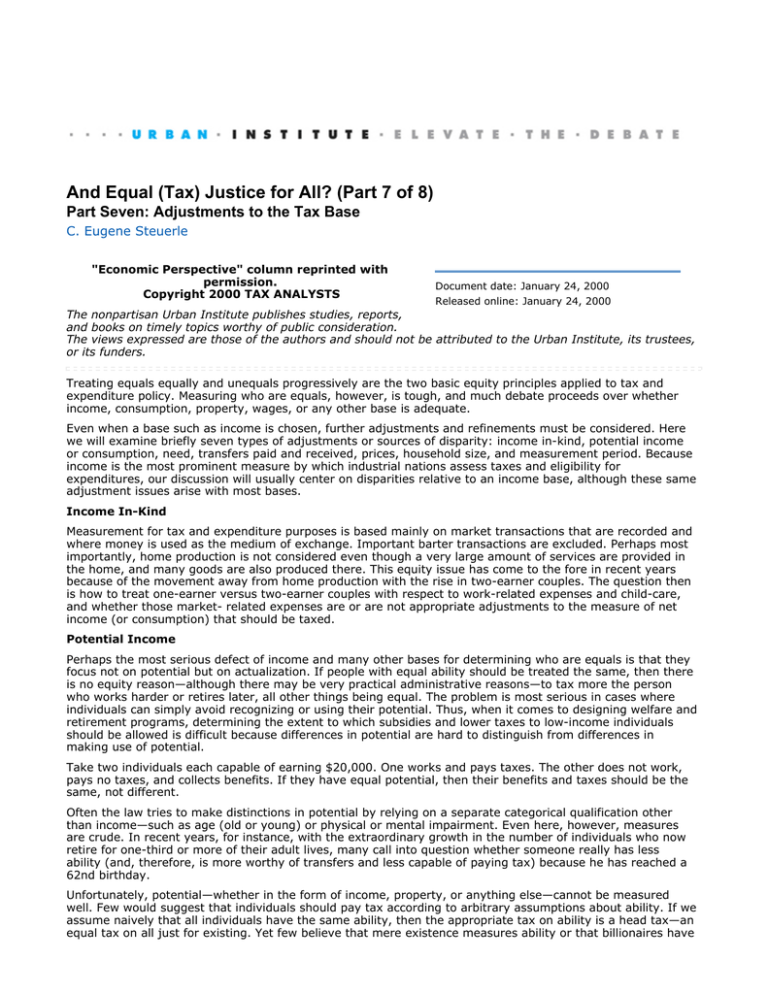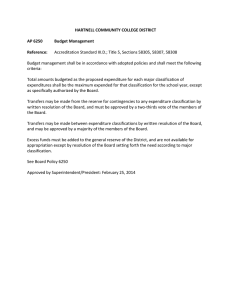And Equal (Tax) Justice for All? (Part 7 of 8)
advertisement

And Equal (Tax) Justice for All? (Part 7 of 8) Part Seven: Adjustments to the Tax Base C. Eugene Steuerle "Economic Perspective" column reprinted with permission. Copyright 2000 TAX ANALYSTS Document date: January 24, 2000 Released online: January 24, 2000 The nonpartisan Urban Institute publishes studies, reports, and books on timely topics worthy of public consideration. The views expressed are those of the authors and should not be attributed to the Urban Institute, its trustees, or its funders. Treating equals equally and unequals progressively are the two basic equity principles applied to tax and expenditure policy. Measuring who are equals, however, is tough, and much debate proceeds over whether income, consumption, property, wages, or any other base is adequate. Even when a base such as income is chosen, further adjustments and refinements must be considered. Here we will examine briefly seven types of adjustments or sources of disparity: income in-kind, potential income or consumption, need, transfers paid and received, prices, household size, and measurement period. Because income is the most prominent measure by which industrial nations assess taxes and eligibility for expenditures, our discussion will usually center on disparities relative to an income base, although these same adjustment issues arise with most bases. Income In-Kind Measurement for tax and expenditure purposes is based mainly on market transactions that are recorded and where money is used as the medium of exchange. Important barter transactions are excluded. Perhaps most importantly, home production is not considered even though a very large amount of services are provided in the home, and many goods are also produced there. This equity issue has come to the fore in recent years because of the movement away from home production with the rise in two-earner couples. The question then is how to treat one-earner versus two-earner couples with respect to work-related expenses and child-care, and whether those market- related expenses are or are not appropriate adjustments to the measure of net income (or consumption) that should be taxed. Potential Income Perhaps the most serious defect of income and many other bases for determining who are equals is that they focus not on potential but on actualization. If people with equal ability should be treated the same, then there is no equity reason—although there may be very practical administrative reasons—to tax more the person who works harder or retires later, all other things being equal. The problem is most serious in cases where individuals can simply avoid recognizing or using their potential. Thus, when it comes to designing welfare and retirement programs, determining the extent to which subsidies and lower taxes to low-income individuals should be allowed is difficult because differences in potential are hard to distinguish from differences in making use of potential. Take two individuals each capable of earning $20,000. One works and pays taxes. The other does not work, pays no taxes, and collects benefits. If they have equal potential, then their benefits and taxes should be the same, not different. Often the law tries to make distinctions in potential by relying on a separate categorical qualification other than income—such as age (old or young) or physical or mental impairment. Even here, however, measures are crude. In recent years, for instance, with the extraordinary growth in the number of individuals who now retire for one-third or more of their adult lives, many call into question whether someone really has less ability (and, therefore, is more worthy of transfers and less capable of paying tax) because he has reached a 62nd birthday. Unfortunately, potential—whether in the form of income, property, or anything else—cannot be measured well. Few would suggest that individuals should pay tax according to arbitrary assumptions about ability. If we assume naively that all individuals have the same ability, then the appropriate tax on ability is a head tax—an equal tax on all just for existing. Yet few believe that mere existence measures ability or that billionaires have no more potential for paying tax than anyone else. There is less difficulty in assessing ability among those who work full-time. Differences in wage rates are highly correlated with differences in potential. Even here, however, it is clear that some jobs are easier than others, and some persons are glad to earn less in exchange for more leisure on the job. Need While many may have the same potential to earn income or realize the same amount of income, they do not necessarily have the same level of need. For example, one person may be in poor health and have large medical expenses. Few would argue that someone with $50,000 of income and $25,000 of annual medical expenses has the same ability to pay tax or the same need for government subsidy as someone who has the same income and is identical in all other respects except that he has no medical expenses. One family may have a child who learns easily, another family may face additional burdens to help its children deal with educational impairments. Some may live in colder areas and require more clothes and energy than those who live in warmer areas. Adjustments for Transfers Tax and expenditure systems also make adjustments, albeit inconsistently, for transfers made and received. The core issue is whether to measure the ability of the household before or after transfers are made. For example, the existence of tax breaks for households with nonworking spouses reflects in part a view that some of the income of the earner is transferred to the spouse, who should be granted his or her own tax-free level of income. Charitable deductions are allowed partly on the theory that one wants to tax the transferor on net income available for consumption, although a strict but unenforceable adherence to consistency would then require that the beneficiaries be taxed on transfers received. Federal deductions for state and local taxes follow a similar transfer logic: if the tax does not generate services closely related to the amount of tax paid, then those taxes are less like fees and more like transfer payments to the eventual beneficiaries of the services. Whatever the income of the beneficiaries, the taxpayer's income is less by the amount of tax transferred. Adjustments for Prices Still another problem arises when $1 of income is not really worth the same in different jurisdictions. Suppose it costs $20,000 in New York City to achieve the same standard of living $10,000 will buy in Lexington, Kentucky. Then a person with $20,000 in New York City would not have an equal ability to pay tax. Adjusting for prices, however, is not easy. In national income accounting, there is no pure way to compare one set of prices with another. Moreover, where there are multiple differences in price, comparisons of income can be done using multiple scales. For example, suppose that rent, food, and clothing all cost twice as much in New York, but only New York offers access to Broadway plays. For a person uninterested in those plays, New York may look expensive relative to Lexington, but for one whose life is consumed by such plays, New York is a real bargain. Once differences are established on average for one region versus another, moreover, the intraregional differences are often as important or more important than the interregional differences. Adjustments for Family Size One of the problems of both tax and expenditure theory centers on what is called the "household unit." For example, if the goal is to tax all units in equal circumstances equally, how should one compare one-person with two-person families? One attempt to measure equals according to family size is through an "equivalence scale." Despite its esoteric name, most people deal with these types of scales all the time. Perhaps the most familiar application is to poverty. When the government reports so many individuals in poverty, it is measuring their income against an equivalence scale. That scale might treat a single individual with, say, $8,000 of income as being in poverty, whereas for a married couple the equivalent standard might be $11,500, and for a married couple with two children it might equal $16,000. Here there are two types of adjustments. Each additional individual in the family is generally treated as costing marginally less to support at a given standard of living, and children are usually treated as costing less than an adult. Equivalence scales are based on the notion that there are economies of scale in living together. Yet the application is quite arbitrary. For instance, adults living together include students in dormitories, elderly in old-age homes, unmarried couples living together, friends in shared apartments, and married couples sharing a home. Typically, tax and expenditure systems force equivalence scale adjustments on two adults only if they marry, regardless of whether they live together and achieve the economies of scale or not. On the other hand, tax systems often treat income as if it is shared among married couples in some split, such as 70-30 or 50- 50. In a progressive income tax such as in the United States this allows those with more uneven splits—say, 90-10—to effectively push more income (in this case, 30 percent rather than 10 percent for the low-earning spouse) into the lower tax brackets. Here a "marriage bonus" is created—thus taxing two married adults with very unequal incomes less than two adults with equivalent incomes living separately. Endowment and the Accounting Period A final and crucial issue often ignored is that most tax systems choose an arbitrary accounting period over which to tax or determine expenditures. The arbitrariness is largely a function of practical administration: the tax system latches onto the conventions of financial accounting with its annual focus. Nonetheless, a 5- or 10- year period, or even a lifetime, would represent a different way of measuring who are equals and who are not. Many years ago I showed how endowment could be considered as equal to the present value of wages and inheritances received and also equal to the present value of consumption and inheritances made. According to this accounting, one might not want to tax capital income during life, since that would penalize a person according to when she saved and consumed rather than how much she had available to consume or transfer over a lifetime. Thus, if one ignores transfers, this lifetime perspective provides some justification for a consumption tax over an annual income tax. If one takes transfers into account, however, then this perspective suggests that we could tax those with equal endowments equally if we had either a wage tax backed up by an inheritance tax or a consumption tax backed up by an estate tax. In that last case, however, the tax should be considered more like a lifetime income tax than a consumption tax. Other Publications by the Authors C. Eugene Steuerle Usage and reprints: Most publications may be downloaded free of charge from the web site and may be used and copies made for research, academic, policy or other non-commercial purposes. Proper attribution is required. Posting UI research papers on other websites is permitted subject to prior approval from the Urban Institute—contact publicaffairs@urban.org. If you are unable to access or print the PDF document please contact us or call the Publications Office at (202) 261-5687. Disclaimer: The nonpartisan Urban Institute publishes studies, reports, and books on timely topics worthy of public consideration. The views expressed are those of the authors and should not be attributed to the Urban Institute, its trustees, or its funders. Copyright of the written materials contained within the Urban Institute website is owned or controlled by the Urban Institute. Source: The Urban Institute, © 2012 | http://www.urban.org

